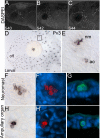Evolution of electrosensory ampullary organs: conservation of Eya4 expression during lateral line development in jawed vertebrates
- PMID: 23017075
- PMCID: PMC4224121
- DOI: 10.1111/j.1525-142X.2012.00544.x
Evolution of electrosensory ampullary organs: conservation of Eya4 expression during lateral line development in jawed vertebrates
Abstract
The lateral line system of fishes and amphibians comprises two ancient sensory systems: mechanoreception and electroreception. Electroreception is found in all major vertebrate groups (i.e. jawless fishes, cartilaginous fishes, and bony fishes); however, it was lost in several groups including anuran amphibians (frogs) and amniotes (reptiles, birds, and mammals), as well as in the lineage leading to the neopterygian clade of bony fishes (bowfins, gars, and teleosts). Electroreception is mediated by modified "hair cells," which are collected in ampullary organs that flank lines of mechanosensory hair cell containing neuromasts. In the axolotl (a urodele amphibian), grafting and ablation studies have shown a lateral line placode origin for both mechanosensory neuromasts and electrosensory ampullary organs (and the neurons that innervate them). However, little is known at the molecular level about the development of the amphibian lateral line system in general and electrosensory ampullary organs in particular. Previously, we identified Eya4 as a marker for lateral line (and otic) placodes, neuromasts, and ampullary organs in a shark (a cartilaginous fish) and a paddlefish (a basal ray-finned fish). Here, we show that Eya4 is similarly expressed during otic and lateral line placode development in the axolotl (a representative of the lobe-finned fish clade). Furthermore, Eya4 expression is specifically restricted to hair cells in both neuromasts and ampullary organs, as identified by coexpression with the calcium-buffering protein Parvalbumin3. As well as identifying new molecular markers for amphibian mechanosensory and electrosensory hair cells, these data demonstrate that Eya4 is a conserved marker for lateral line placodes and their derivatives in all jawed vertebrates.
© 2012 Wiley Periodicals, Inc.
Figures




References
-
- Alves-Gomes JA. The evolution of electroreception and bioelectrogenesis in teleost fish: a phylogenetic perspective. J. Fish Biol. 2001;58:1489–1511.
-
- Bessarab DA, Chong SW, Korzh V. Expression of zebrafish six1 during sensory organ development and myogenesis. Dev. Dyn. 2004;230:781–786. - PubMed
-
- Bodznick D, Montgomery JC. The physiology of low-frequency electrosensory systems. In: Bullock TH, Hopkins CD, Popper AN, Fay RR, editors. Electroreception. Springer; New York: 2005. pp. 132–153.
-
- Bullock TH, Hopkins CD, Popper AN, Fay RR, editors. Electroreception. Springer; New York: 2005.
MeSH terms
Substances
Grants and funding
LinkOut - more resources
Full Text Sources
Research Materials

